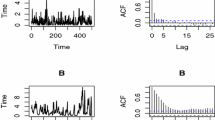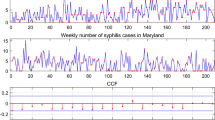Abstract
We propose a generalized mixture integer-valued generalized autoregressive conditional heteroscedastic model to provide a more flexible modeling framework. This model includes many mixture integer-valued models with different distributions already studied in the literature. The conditional and unconditional moments are discussed and the necessary and sufficient first- and second-order stationary conditions are derived. We also investigate the theoretical properties such as strict stationarity and ergodicity for the mixture process. The conditional maximum likelihood estimators via the EM algorithm are derived and the performances of the estimators are studied via simulation. The model can be selected in terms of both the number of mixture regimes and the number of orders in each regime by several different criteria. A real-life data example is also given to assess the performance of the model.





Similar content being viewed by others
References
Aitkin M, Rubin DB (1985) Estimation and hypothesis testing in finite mixture models. J R Stat Soc Ser B 47:67–75
Christou V, Fokianos K (2014) Quasi-likelihood inference for negative binomial time series models. J Time Ser Anal 35:55–78
Diop ML, Diop A, Diongue AK (2016) A mixture integer-valued GARCH model. REVSTAT Stat J 14:245–271
Diop ML, Diop A, Diongue AK (2018) A negative binomial mixture integer-valued GARCH model. Afrika Stat 3:1645–1666
Doukhan P, Fokianos K, Rynkiewicz J (2018) Mixtures of nonlinear Poisson autoregression. Working paper. http://www.researchgate.net/publication/326478827
Doukhan P, Fokianos K, Tjøtheim D (2012) On weak dependence conditions for Poisson autoregressions. Stat Prob Lett 82:942–948
Doukhan P, Wintenberger O (2008) Weakly dependent chains with infinite memory. Stoch Process Appl 118:1997–2013
Ferland R, Latour A, Oraichi D (2006) Integer-valued GARCH process. J Time Ser Anal 27:923–942
Fokianos K, Tjøtheim D (2012) Nonlinear Poisson autoregression. Ann Inst Stat Math 64:1205–1225
Fokianos K, Rahbek A, Tjøstheim D (2009) Poisson autoregression. J Am Stat Assoc 104:1430–1439
Hafidi B, Mkhadri A (2010) The Kullback information criterion for mixture regression models. Stat Prob Lett 80:807–815
Khalili A, Chen J, Stephens DA (2017) Regularization and selection in Gaussian mixture of autoregressive models. Can J Stat 45:356–374
Li Q, Lian H, Zhu F (2016) Robust closed-form estimators for the integer-valued GARCH(1,1) model. Comput Stat Data Anal 101:209–225
Liboschik T, Fokianos K, Fried R (2017) tscount: an R package for analysis of count time series following generalized linear models. J Stat Softw 82:1–51
Naik PA, Shi P, Tsai CL (2007) Extending the Akaike information criterion to mixture regression models. J Am Stat Assoc 102:244–254
Neumann MH (2011) Absolute regularity and ergodicity of Poisson count processes. Bernoulli 17:1268–1284
Weiß CH (2009) Modelling time series of counts with overdispersion. Stat Methods Appl 18:507–519
Weiß CH (2010) The INARCH(1) model for overdispersed time series of counts. Commun Stat Simul Comput 39:1269–1291
Xu H, Xie M, Goh TN, Fu X (2012) A model for integer-valued time series with conditional overdispersion. Comput Stat Data Anal 56:4229–4242
Zhu F (2011) A negative binomial integer-valued GARCH model. J Time Ser Anal 32:54–67
Zhu F (2012a) Modelling overdispersed or underdispersed count data with generalized Poisson integer-valued GARCH models. J Math Anal Appl 389:58–71
Zhu F (2012b) Zero-inflated Poisson and negative binomial integer-valued GARCH models. J Stat Plan Inference 142:826–839
Zhu F, Li Q, Wang D (2010) A mixture integer-valued ARCH model. J Stat Plan Inference 140:2025–2036
Zhu F, Shi L, Liu S (2015) Influence diagnostics in log-linear integer-valued GARCH models. AStA Adv Stat Anal 99:311–335
Zhu F, Liu S, Shi L (2016) Local influence analysis for Poisson autoregression with an application to stock transaction data. Stat Neerl 70:4–25
Acknowledgements
We are very grateful to the Editor and the anonymous referee for providing several exceptionally helpful comments which led to a significant improvement of the paper.
Author information
Authors and Affiliations
Corresponding author
Additional information
Publisher's Note
Springer Nature remains neutral with regard to jurisdictional claims in published maps and institutional affiliations.
This work is supported by National Natural Science Foundation of China (Nos. 11871027, 11731015), Science and Technology Developing Plan of Jilin Province (No. 20170101057JC), and Cultivation Plan for Excellent Young Scholar Candidates of Jilin University.
Appendix
Appendix
Proof of Theorem 1
Let \(\mu _t=\mathbb {E}(X_t)=\sum _{k=1}^\infty \alpha _k\mathbb {E}(\lambda _{kt})\) for all \(t\in \mathbb {Z}\). By the idea of Lemma 1 in Doukhan et al. (2018), we know that the mean process \(\lambda _{kt}\) has an infinite presentation of \(X_t\) under Assumption 1, i.e.,
where \(C_{k0}=\alpha _{k0}+\sum _{l=1}^{\infty }\sum _{j_1,\ldots ,j_l=1}^{L} \alpha _{k0}\beta _{kj_1}\cdots \beta _{kj_l}= \alpha _{k0}/\left( 1-\sum _{j=1}^{L}\beta _{kj}\right) .\) Therefore, we have
The necessary and sufficient condition for a non-homogeneous difference equation (A.1) to have a stable solution, which is finite and independent of t, is that all roots of the equation
should lie inside the unit circle. Since Assumption 1 guarantees that for \(k=1,\ldots ,K,~\sum _{j=1}^{q_k}\beta _{kj}<1\), then Eq. (2) follows.
Proof of Theorem 2
Let \(\gamma _{it}=\mathbb {E}(X_tX_{t-i})\), for \(i=0,1,\ldots ,L\), consider the conditional second moment,
For \(k=1,\ldots ,K\), we have
Recalling the infinite presentation of \(\lambda _{kt}\) under the Assumption 1, we can calculate the expectations \(X_{t-i}\lambda _{kt}\) and \(\lambda _{k(t-j)}\lambda _{kt}\) as follows:
Similarly, we can get
Hence
where \(C_{k0}=\alpha _{k0}+\sum _{l=1}^{\infty }\sum _{j_1,\ldots ,j_l=1}^{L}\alpha _{k0} \beta _{kj_1}\cdots \beta _{kj_l}, C_k=\alpha _{k0}\mathbb {E}(\lambda _{kt})+C_{k0}\mu \sum _{i=1}^{L}\alpha _{ki}+C_{k0}^2 \sum _{j=1}^{L}\beta _{kj}+2C_{k0}\mu \sum _{l=0}^{\infty }\sum _{j_1,\ldots ,j_{l+2}=1}^{L} \alpha _{kj_{l+2}}\beta _{kj_1}\cdots \beta _{kj_{l+1}}\) is a constant independent of t under the condition of first order stationary,
Then
Let \(\gamma _{it}=\mathbb {E}(X_tX_{t-i})\). Since the conditional mean of the process is \(\mathbb {E}(X_t|\mathcal {F}_{t-1})=\sum _{k=1}^{K}\alpha _{k}\lambda _{kt}\), which is the same as that of the model proposed by Diop et al. (2016). So after some tedious calculations, we can get
where \(\delta _{ivkl}=\sum _{|i-j_1-\cdots -j_{l+1}|=v}\alpha _{kj_{l+1}}\beta _{kj_1}\cdots \beta _{kj_{l}}\) and \(K_1=\mu \sum _{l=0}^{\infty }\sum _{k=1}^{K}\sum _{j_1,\ldots ,j_l=1}^{L}\alpha _{k0}\alpha _{k} \beta _{kj_1}\cdots \beta _{kj_{l}}\).
We obtain, for \(i=1,\ldots ,L\),
where \(\omega _{i0}=\sum _{l=0}^{\infty }\sum _{k=1}^{K}\alpha _{k}\delta _{i0kl}\), \(\omega _{iv}=\sum _{l=0}^{\infty }\sum _{k=1}^{K}\alpha _{k}\delta _{ivkl} (i\ne v)\) and \(\omega _{ii}=\sum _{l=0}^{\infty }\sum _{k=1}^{K}\alpha _{k}\delta _{iikl}-1\). Let \(\Gamma =(\omega _{ij})_{i,j=1}^{L-1}\) and \(\Gamma ^{-1}=(b_{ij})_{i,j=1}^{L-1}\) its inverse whose existence is a consequence of the first-order stationary (for more details, see Appendix B of Diop et al. (2016)). Then \(\gamma _{vt}=-K_1\sum _{u=1}^{L-1}b_{vu}-\sum _{u=1}^{L-1}b_{vu}\omega _{u0}\gamma _{0(t-u)}\). Finally
Hence
where \(c_0=\sum _{k=1}^K\alpha _kv_{k0}\mathbb {E}(\lambda _{kt})+\sum _{k=1}^K\alpha _k (1+v_{k1})C_k-K_1\sum _{k=1}^K\alpha _k(1+v_{k1})\sum _{v=1}^{L-1} \Lambda _{kv}\sum _{u=1}^{L-1}b_{vu}\). Let \(c_u=\sum _{k=1}^K\alpha _k(1+v_{k1}) \left( \Delta _{ku}-\sum _{v=1}^{L-1}\Lambda _{kv}b_{vu}\omega _{u0}\right) \), \(u=1,\ldots ,L-1\) and \(c_L=\sum _{k=1}^K\alpha _k(1+v_{k1})\Delta _{kL}\). Then the Eq. (A.2) is equivalent to:
Therefore, the the non-homogeneous difference equation has a stable solution if the equation all roots of \(1-c_1Z^{-1}-\cdots -c_LZ^{-L}=0\) lie inside the unit circle.
Proof of Theorem 3
The proof is based on checking Condition 3.1 of Doukhan and Wintenberger (2008) since Condition 3.2 is assumed and Condition 3.3 of the same article holds trivially. As discussed before, the NB-MINGARCH model can be approximated by a NB-MARCH(\(\infty \)) model under the Assumption 1. So similar to (3), it is also defined as the following form:
where \(\epsilon _t=(\widetilde{N}_t,\eta _t)\) is the noise sequence and \(\widetilde{N}_t,~\eta _t\) and \(Z_{kt}\) are independent for \(t\in \mathbb {Z}\). Set \(\mathbf {x}=(x_1,x_2,\ldots )\) and \(\tilde{\mathbf {x}}=(\tilde{x}_1,\tilde{x}_2,\ldots )\in \mathbb {N}^\infty \). Then, we have
where \(\{c_{ki}\}\) is a sequence of coefficients defined in Sect. 2.2. The first and second equalities hold because of conditioning, the third equality follows from the properties of the Poisson process \(\widetilde{N}_t\), the fourth equality is true as the random variable \(Z_{kt}\) is positive with mean 1 and the last inequality holds by Lemma 2.1 in Doukhan et al. (2018). Hence, by Theorem 3.1 of Doukhan and Wintenberger (2008), there exists a unique \(\tau \)-dependent solution of model which is a stationary and ergodic process.
Rights and permissions
About this article
Cite this article
Mao, H., Zhu, F. & Cui, Y. A generalized mixture integer-valued GARCH model. Stat Methods Appl 29, 527–552 (2020). https://doi.org/10.1007/s10260-019-00498-2
Accepted:
Published:
Issue Date:
DOI: https://doi.org/10.1007/s10260-019-00498-2




